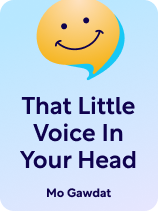

This article is an excerpt from the Shortform book guide to "That Little Voice In Your Head" by Mo Gawdat. Shortform has the world's best summaries and analyses of books you should be reading.
Like this article? Sign up for a free trial here.
What’s That Little Voice in Your Head by Mo Gawdat about? Can you program your brain to be happier?
In That Little Voice in Your Head, Mo Gawdat explains your brain functions like a computer. He explores how it causes unhappiness and replaces these functions with new ones that will ensure happiness.
Read below for a brief overview of That Little Voice in Your Head.
That Little Voice in Your Head by Mo Gawdat
Like many people, Mo Gawdat was trapped in a cycle of negative thoughts and emotions until, after the death of his beloved son, he devised a formula to escape. Based on his background as a software engineer, Gawdat realized that our brains function like computers: We give them input, they process that input, and based on the processing code they use, the output is either happiness or unhappiness. So, if we want to be happy, all we need to do is alter our brain’s coding system. In That Little Voice In Your Head, Mo Gawdat explains how to understand and program your brain so you can experience the world in ways that produce positive actions and emotions.
Mohammed “Mo” Gawdat is an entrepreneur, software engineer, and businessman. However, despite his massive successes, including being the former chief business officer of Google [X], Gawdat struggled to find happiness. This struggle continued until the death of his son Ali triggered an awakening for him—he learned from his son’s endless positivity and compassion that regardless of life circumstances, you’re ultimately the one who controls your happiness.
In memory of his son, Gawdat has dedicated himself to helping as many people as possible to achieve happiness. Under this mission, Gawdat has written Solve for Happy, created the mental health podcast Slo Mo, founded One Billion Happy, and co-founded Unstressable. That Little Voice In Your Head continues this mission.
Part 1: Your Brain Functions Like a Computer
Gawdat argues that at its core, your brain is a computer, and its job is to understand the world and tell you how to react. So, to understand how your brain works, you must also understand how a computer works: First, a computer is given input—for example, the math problem 2×2. Based on the input it’s given, it selects a method to process the information—in this case, the method would be multiplication. Then, it performs the method (multiplication) and communicates the output—4.
Your brain goes through the same process—first we feed it information (inputs). Once your brain receives information, it selects a method to understand (process) that information. Finally, it communicates its findings to you through thoughts (what Gawdat refers to as “that little voice in your head”). Our thoughts trigger emotions, and our emotions cause us to feel either happy or unhappy.
Gawdat explains that unhappiness occurs when there’s an error somewhere in this process. The first step in ensuring our brain directs us to happiness is to identify the four main errors that occur during processing—we’ll do this troubleshooting in the next section.
Part 2: Troubleshooting Your Brain
Gawdat identifies four processing errors that cause our brains to produce unhappiness. In this section, we’ll discuss each error and explain why it causes unhappiness.
Processing Error #1: Inaccurate Information
The first common error happens on the front end of the process—you’ve fed your brain inaccurate information (input) that sets the system up for failure. For instance, imagine that you want a computer to give you the answer for 2×2 but your input is 1x2—you won’t get the output you want. In the same sense, if you want your brain to produce happiness, you must ensure that you’re feeding it the proper information to produce that result.
Processing Error #2: Evolutionary Overdrive Kicks In
The second common processing error is when our evolutionary survival instincts kick in—when our brain tells us to fear and avoid something, to protect something, or to want for something better. Gawdat says these instincts are often problematic because, unlike our ancient environment, which required us to rely on them for survival, virtually none of the issues the average person experiences today are serious enough to require these reactions. Instead, they cause us to perceive simple things as a worst-case scenario and result in unnecessary levels of stress and dissatisfaction.
Processing Error #3: Using the Wrong Side of Your Brain
Gawdat explains that the third processing error occurs when we use the wrong side of our brain to process and respond to the information we’ve fed it. He says the left and right sides of our brains have different functions and ways of solving problems—the left side is critical and analytical, and the right side is intuitive and creative.
The left side helps us solve problems, set goals, plan, and so on. The right side helps us build and maintain relationships, feel emotions, appreciate art, play, and be curious. Put simply, the left brain deals with the tangible while the right brain deals with the intangible. Gawdat explains that both sides are important, but unhappiness occurs when we overuse the left side of our brain and underuse the right side of our brain.
There are a few reasons why over-relying on one side of the brain causes unhappiness.
First, overusing the left side of your brain causes you to overanalyze things—this leads you to ruminate and create problems that aren’t there. For example, if your boss had an exasperated tone, you might overuse the left side of your brain and spend the day wondering why and if you did something wrong. This approach causes unnecessary stress and anxiety, which leads to unhappiness. Instead, you could use the right side of your brain to empathize—realize that your boss probably just had a stressful day. Instead of catastrophizing with your left side, you could use your right side rationale to extend kindness and ask if there’s anything you can do to help.
Second, says Gawdat, overusing the left side of your brain blocks your intuition and emotions. This can cause you to make poor decisions that undermine your happiness. For example, overusing your left brain might cause you to leave a job where you’re fulfilled and financially stable for a job you hate but that pays more—a decision that ultimately makes you unhappy in life. Or, you may distance yourself from a person you love because you feel your emotions will hinder your progress at work—which leaves you unhappy and always wondering “what if.”
Ultimately, Gawdat says that to be successful and happy, you must use the right side of your brain before solely acting on what your logical left side tells you.
Processing Error #4: Undirected Thinking
The final processing error that Gawdat says leads to unhappiness is undirected thinking—letting our mind wander. Research shows that when we allow our mind to wander, part of our brain almost always begins to focus on negative thoughts—this is human nature. And when you start to ruminate on negativity—what you should have done, what you’d rather be doing, why you’re not good enough, and so on—you start to feel emotions like regret, self-pity, and boredom that make you unhappy.
Instead, Gawdat says you must learn how to focus because when your attention is focused, rumination can’t take over. Further, when a ruminative thought crops up, Gawdat recommends acknowledging the thought by saying it out loud—sometimes your mind just wants you to acknowledge something and, once you do, you’ll be able to move on because you convince your brain that the “problem” will be handled.
Part 3: Programming for Happiness
In this section, we’ll discuss the four tips Gawdat recommends to help your brain process and respond to information in ways that lead to happiness.
Programming Tip #1: Observe the World Around You
Gawdat recommends you actively observe the world around you and intentionally spend your time and attention on positive things. The purpose of this is two-pronged: First, focusing your mind on the details of the world around you will help direct your thinking to positivity rather than rumination (avoiding Error #4). Second, focusing on the world around you can lead to happiness because you’ll notice more things to be grateful for.
For example, be aware of beauty as you walk to work and snap a picture when you find it. Intentionally looking for beauty accomplishes three things: 1) It keeps your mind busy so you can’t ruminate, 2) it allows you to focus on positive things that make you happy rather than sights that annoy you (like litter), and 3) it helps you appreciate small details about your neighborhood that you wouldn’t have noticed before—even more to be happy about!
Gawdat explains that choosing to direct your mind is intentional—you must actively set out to do this every day for it to become a habit that can replace the errors discussed in the previous section. He explains that focusing your attention makes you happier because it functions as a form of meditation—and it makes you more compassionate and empathetic.
Programming Tip #2: Check Yourself
Gawdat’s second tip to program your brain for happiness is to check how you’re perceiving and reacting to the world around you. This will ensure that you’re only allowing accurate information (inputs) into your brain, that you’re solving problems effectively, and that you’re handling ruminative thoughts before they take control of your mind. (This addresses Error #1: inaccurate thoughts and Error #4: undirected thinking.)
Programming Tip #3: Get Into Flow
Gawdat’s third tip to program your brain for happiness is to get into a state of “flow.” Flow is a state of intense, uninterrupted focus where your environment fades into the background, time flies, and your productivity, creativity, and overall performance soar. Gawdat says that reaching flow makes us happier not only because it allows us to direct our mind (avoiding Error #4), but also because of the chemicals our brain releases in this state.
In flow, writes Gawdat, our brain releases norepinephrine, serotonin, dopamine, and anandamide. Norepinephrine triggers flight-or-fight mode and gives us the focus needed to escape danger. Serotonin is the chemical of calmness and happiness and subdues the effects of norepinephrine so that we can get the high focus it provides without the stress and fear we would normally experience. This combination then causes our brains to release dopamine—the happiness chemical. Anandamide is also released, which boosts memory and creativity.
Gawdat says two factors are required to reach a state of flow.
First, to reach flow you must dedicate a block of uninterrupted time to the task. This is because it takes time to reach flow—unless you’re an expert, it’s unlikely you’ll be able to sit down and immediately reach this state. Rather, as you work, the task will seem harder and harder until your focus peaks and you enter flow—at this point, the task will seem a bit easier, and you’ll get a better grasp of how to accomplish your goal. Further, every time you’re interrupted, you’ll break flow and have to take time to get back into it—avoid this by making sure in advance that you won’t be interrupted.
Second, a task must be difficult but doable in order for you to reach a state of flow. Gawdat says easy tasks don’t require your full attention, and therefore your brain has room to wander. To reach flow, the task you’re performing must command your full attention and abilities. However, if the task is too hard, you’ll be unable to progress and therefore unable to reach flow.
Programming Tip #4: Give to Others
Gawdat’s final tip for programming your brain for happiness is giving to others. He says that of all the tips he offers, giving and making others happy has brought him the most happiness. There’s no concrete explanation for why giving makes us happy, but our evolutionary instinct may play a part. Gawdat suggests that we take pleasure from giving to others because humans must support each other to survive—if we feel good when giving, it ensures we’ll help those who need it and the species will continue.
Gawdat makes a few recommendations to practice giving to others.
First, give away the things you don’t need—clothes, items, money, and so on. As we discussed in Error #2, the more things that you have, the more power that those things have over your happiness. So, figure out what you can spare, and give it to others who need it more. For example, if you never wear your mother’s old ring, and it sits inside a box in your closet, you could give it to a friend who wants to propose to their partner but can’t afford a ring. If you never look at the ring, you won’t miss it, but for your friend, it will mean the world.
Second, says Gawdat, practice the art of giving to others what you give to yourself. For example, if you buy yourself a strawberry donut, buy an extra one and give it to your coworker. You don’t have to do this all the time, but try to do it once or twice a week.

———End of Preview———
Like what you just read? Read the rest of the world's best book summary and analysis of Mo Gawdat's "That Little Voice In Your Head" at Shortform.
Here's what you'll find in our full That Little Voice In Your Head summary:
- How to understand and program your brain to produce positive actions and emotions
- The four processing errors that cause our brains to produce unhappiness
- Why you should get into the flow state more often






